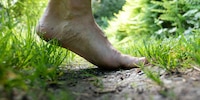
Background information
"I have learnt that running can feel really great"
by Michael Restin

I wanted to train barefoot and I discovered the truth: my body needs more repair work than the A1. The main problem is at the top. To work on all these points in depth, it's mainly the head that's called upon.
I don't know if I look like Gollum, the hunchback of Notre Dame, or if I stand up straight like a Swiss guard. Is my neck straight, my ribcage relaxed and tilted back and my knee just above my second toe? The challenge ahead is surmountable: climbing two steps. Instead of unrolling my sequences of movements shaped over almost 40 years, I have to get it right this time. One small step for me, one giant leap for my brain.
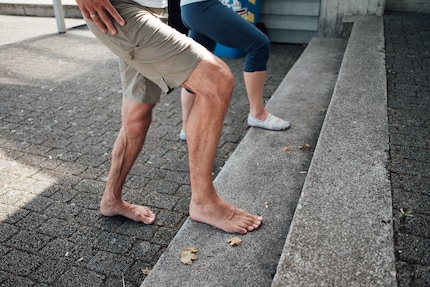
"It's like leaving the motorway and driving on a dirt road," explains physiotherapist Veronika Wanner. Nothing is taken for granted, progress is slow and hesitant. I don't feel like a car either, because nothing works automatically. I feel more like a badly programmed robot. Veronika helps me to harmonise the hardware and software. She guides me every step of the way.
You only have to look briefly at my legs to notice my first problem. Instead of straight shins, I'm left with curved shins that seem haphazardly attached to the knees. Above, the thighs, as if embarrassed, turn in another direction. A sculptor in his first year of training would fare better.
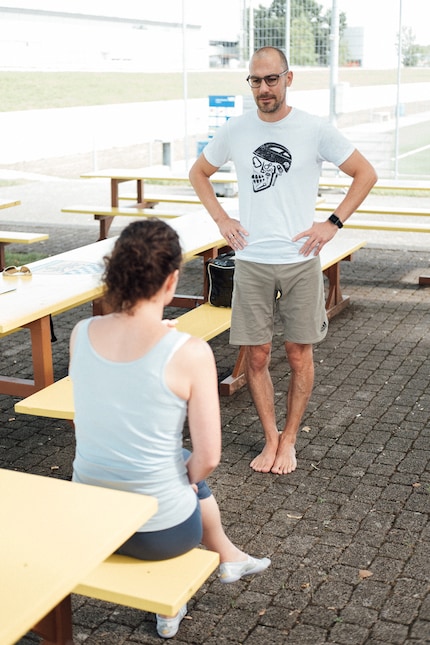
If the knees point straight ahead, the feet are at right angles. If the feet are parallel, the kneecaps are turned inwards. I have more than bow legs. With a bit of imagination, you can recognise half the alphabet. Thank you, genes. Thank you, football. Instead of tying knots in my opponents' legs like the brilliant Garrincha once did, despite his imperfect anatomy, I've become an office worker hunched over my keyboard for eight hours a day. Hello kyphosis and lordosis.
"I rarely see well-coordinated people," says Veronika to console me. Small children generally have very good posture, and a few are lucky enough to keep it into adulthood. "For everyone else, things end up going wrong at some point.
We're back together.
We meet on the pitch of club FC Oberwinterthur to begin the inventory of my body. I'm not naive enough to think that it's just a flat-foot problem and that I'll finally be able to get the maximum power from my movements. There's no way I can go on like this. I'm running out of time and need to make some changes. The Leaning Tower of Pisa would have collapsed a long time ago without restoration work.
"Do you have any pains or problems?" begins Veronika, taking notes. I list the problem areas I know about and think mainly about my knees. This anatomically ingenious hinge joint endures a lot over the course of our lives and, strangely enough, it still works relatively well in my case. Sometimes my right knee hurts after a long run or on a steep descent, unlike my acquaintances with perfectly straight legs who regularly suffer torn cruciate ligaments and jammed menisci.
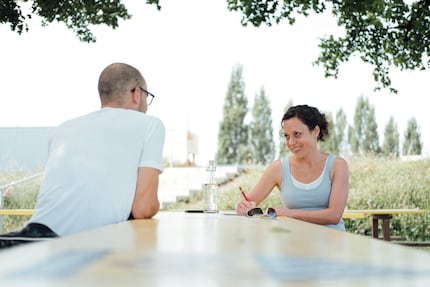
For a while now, I've been testing minimalist shoes and I feel like my knees are responding positively. I contacted Veronika because she has successfully overcome similar problems herself and through her work she helps others to anatomically re-adjust their bodies intelligently.
"Take a few steps please," Veronika tells me. Left, right, left, right, left, right. I'm in control. I do my best, turn around and see Veronika's furrowed eyebrows. "How can I tell her the truth?" she seems to be thinking, before leading me up a few steps and quietly running across the artificial grass. Back and forth along the line.
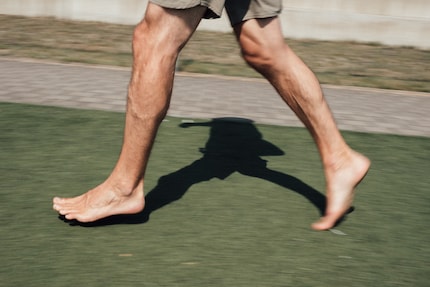
While I was only paying attention to my feet and knees, Veronika analysed all my movements: "The most striking thing is that the axis of your leg isn't straight and your knee turns inwards when it's called upon," the expert announced, starting from the most obvious. But she's far from finished: "When you run, you're asymmetrical. Your right shoulder rises while your pelvis is twisted to the right. There too, the axis of the leg deviates."
Ouch! It's the runner's midlife crisis. Get me a walker! It's hardly flattering to have your own physical shortcomings listed like this. "What should we do about it?" asks Veronika, because an hour's coaching obviously isn't enough to solve everything. Should we concentrate on the legs? Hips? The back? Should it be the shoulders? Or the feet? I opt for the accelerated version of the complete programme. That way, I at least know where we're going. It starts with an elastic band and a bench.
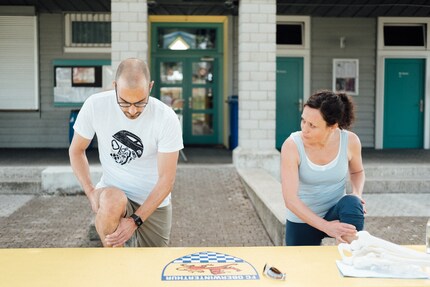
We place the left foot on the bench and push the knee back and forth. "The kneecap should be positioned exactly above the second toe," explains Veronika. "In theory, it's clear what I need to do to counteract this. But for me, it's difficult. When my foot is straight, the knee turns inwards. The lower part of the leg tends to pivot outwards. "With your hands, you can grasp the calf and thigh and accompany the movement," the physio shows me.
Tip to check your posture: sit on a chair in front of a mirror. Feet parallel and straight. The second toe points forward, the knee is in line above the ankle joint. When you stand, your knees should stay in position and not give way.
To achieve the same effect when walking and standing, Veronika makes a bandage with the elastic band. This is wrapped around the foot and then around the lower leg starting from the outside so that the foot turns slightly inwards. The next turn pushes the thigh outwards before the band wraps around the hips and disappears into the waistband.
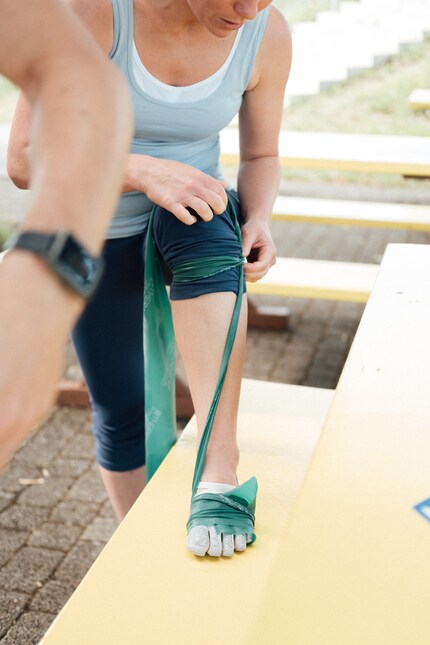
Turning your thigh outwards and your lower leg inwards when walking seems wrong, and yet that's what you should be doing. With every step, with every walk, I have to concentrate and correct my movements according to Veronika's comments. Veronika is a sports scientist specialising in prevention and rehabilitation. It was only after further training in Spiraldynamik that she found what she personally was missing: a clear concept.
An instruction manual for anatomically intelligent movements. These usually include a spiral component; for example, when the spine turns left and then right when walking. Hence the name Spiraldynamik. It's an extremely differentiated approach," says Veronika. For many, it's very difficult at first because it requires a high level of body awareness."
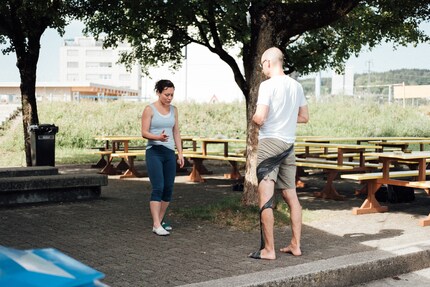
I can see the appeal of this approach, not least because it forces the brain to participate. First observation: the little corrections designed to harmonise everything can be exhausting. Especially for the head, which has to fight against the automated movement sequences. It works if I concentrate on one thing: doing a lunge, climbing a step, getting up from the bench, taking a few steps straight ahead. As soon as the pace picks up, things get complicated.
I undo the elastic band. "How are you doing now?" asks Veronika during the next few steps. It's easier than it was at first, the rubber reminder has served its purpose and continues to work. Nonetheless, more than once I have to call myself to order. "At the beginning, you feel like the last of the idiots", says Veronika. I agree. "By the time you've mastered something, other movements are forgotten again. But this improves over time and the new movement sequences settle in."
Nature has gifted us with seven cervical vertebrae, twelve thoracic vertebrae and five lumbar vertebrae cleverly cushioned and flexibly organised. Veronika has brought along a model and is showing me where I'm putting pressure on her. "You know you tend to arch your back and have a rounded back," she says, bending the plastic spine to illustrate the problem. The natural double-S shape then presents two exaggerated curves. One compensates for the other. It's not good, I'm aware of the problem and I've solved it so far with modest success through stretching, strengthening, various entraîneurs de posture.
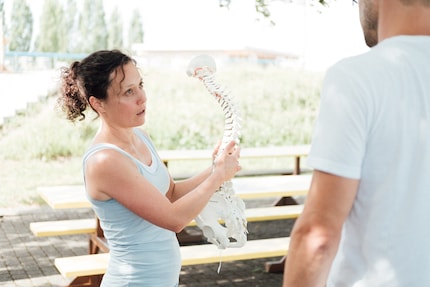
"You have the mobility to straighten your lumbar vertebrae, that's already a positive point," notes Veronika, who has put the plastic model down and is repositioning my back. It's feasible, when I think about it. Until now, I thought it applied to my whole posture: lower the coccyx, bring the shoulder blades together, pull the chin back, and that's it. Wrong! Bringing the shoulder blades together is not what we really want," explains Veronika. The important thing is to get the lower ribs to follow the movement and the ribcage to open up."
Tip to check your posture: stand with your back to a post or door frame and straighten up. The lumbar spine should be one to two fingers apart, the point of contact with the thoracic spine should be relatively low. Ideally, the back of the head rests relaxed on the control line.
Open the ribcage? For me, it's an almost impossible movement. My body has found comfortable alternatives at the cost of some tension. "The lower ribs count enormously in shoulder and back pain, we are rarely aware of this," explains Veronika. As she criticises the position of my ribs and corrects them with gentle pressure, a realisation emerges: I've forgotten the sensations characteristic of ideal posture.
"Now you stand up straight," Veronika concludes. At the same time, I think to myself: it feels strange to be standing like this. During the first exercises, I could look at my knees, now I have no visual cue. In the end, the two steps I have to climb become an obstacle that affects my coordination. Turning the lower leg inwards, turning the thigh outwards, lowering the coccyx, retracting the ribcage... Wait, how was the posture again?
I try to follow Veronika's instructions up and down the steps. With no bearings in space, I take my time. I go up and down. Up and down. Sometimes I get compliments for changes I hardly notice, sometimes I get outright corrections. A straight pelvis! And above all: no more rotation in the thoracic spine.
"This ability to rotate has been lost in the vast majority of people," says Veronika. I unconsciously compensate for this deficiency in other places. That's why she insists: "The lower ribs must remain in place, which automatically blocks excessive mobility at the transition from the lumbar to the thoracic spine." These are small, illuminating details whose full impact I can't yet feel. My head is absorbed, focused on one part of the body at a time.
Finally, Veronika sends me back out onto the artificial turf. I run without even trying to think about everything. I'm more relaxed. The stress of trying to do everything well at once disappears. And what a surprise! My body seems to have memorised the newly learned movement sequences. I pay attention to the rotation and adopt this new posture step by step. I found it really interesting to watch you," Veronika tells me afterwards. The asymmetry you had in your pelvis, shoulder and arm movements reduces considerably as soon as you follow the rotation of the ribcage and straighten the pelvis."
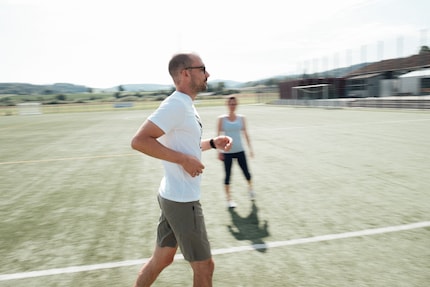
Of course, after an hour, I'm miles away from the upheaval Veronika experienced, the pain-free run, a different body sensation. But I too had a revelation. The body is a complex puzzle. For years, I had put the pieces together incorrectly. On the surface, the overall picture was more or less coherent. I had to look in detail to see where the problems were. Coaching helped me to understand the ins and outs and to tackle the problems individually. I don't know if this road will take me where I want to go, but I'm on the right track.
Simple writer and dad of two who likes to be on the move, wading through everyday family life. Juggling several balls, I'll occasionally drop one. It could be a ball, or a remark. Or both.
Interesting facts about products, behind-the-scenes looks at manufacturers and deep-dives on interesting people.
Show all
Background information
by Michael Restin

Background information
by Michael Restin
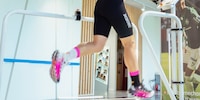
Background information
by Siri Schubert